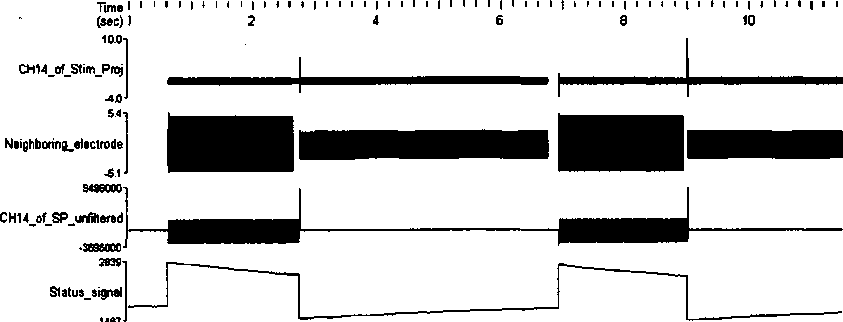143
aforementioned experiment. All switches showed a resistance of 110-150Ω while
closed and showed an open circuit while open, so all were switching properly and no
leakage was detected. To test whether capacitive coupling was the cause, a constant
signal was applied to the saline solution and the Stim Project was repeatedly switched
from stimulate to record. As shown in figure 7A, a sinusoidal signal recorded from the
saline becomes larger when the Stim Project is set to record. If a leaky switch were
present, the opposite would occur since a leaky open switch would have a higher
impedance than a closed switch; but in case of capacitive coupling the amplifier side is
floating when the switch is open, acting like an antenna, hence the larger signal.
Likewise when a square wave is applied as shown in figure 7B, it became heavily
distorted when the Stim Project is set to stimulate, likewise negating the possibility of a
leaky or malfunctioning switch and indicating cross-talk. In general practice the user
would engage the fast settle feature a few milliseconds prior to recording and it would
be disengaged prior to stimulation, in which case this cross-talk will not be visible.

Fig. 6A The result of using the fast-settle feature of the NSA. Notice that the Stim Project can
now record immediately after switching, and that the unfiltered waveform no longer has a
capacitive voltage that remains after switching. Also notice that cross-talk can now be seen
while the Stim Project is stimulating.
More intriguing information
1. The name is absent2. The Impact of Individual Investment Behavior for Retirement Welfare: Evidence from the United States and Germany
3. Real Exchange Rate Misalignment: Prelude to Crisis?
4. The name is absent
5. The name is absent
6. Qualifying Recital: Lisa Carol Hardaway, flute
7. Estimating the Economic Value of Specific Characteristics Associated with Angus Bulls Sold at Auction
8. Conditions for learning: partnerships for engaging secondary pupils with contemporary art.
9. TOWARDS THE ZERO ACCIDENT GOAL: ASSISTING THE FIRST OFFICER MONITOR AND CHALLENGE CAPTAIN ERRORS
10. ISO 9000 -- A MARKETING TOOL FOR U.S. AGRIBUSINESS